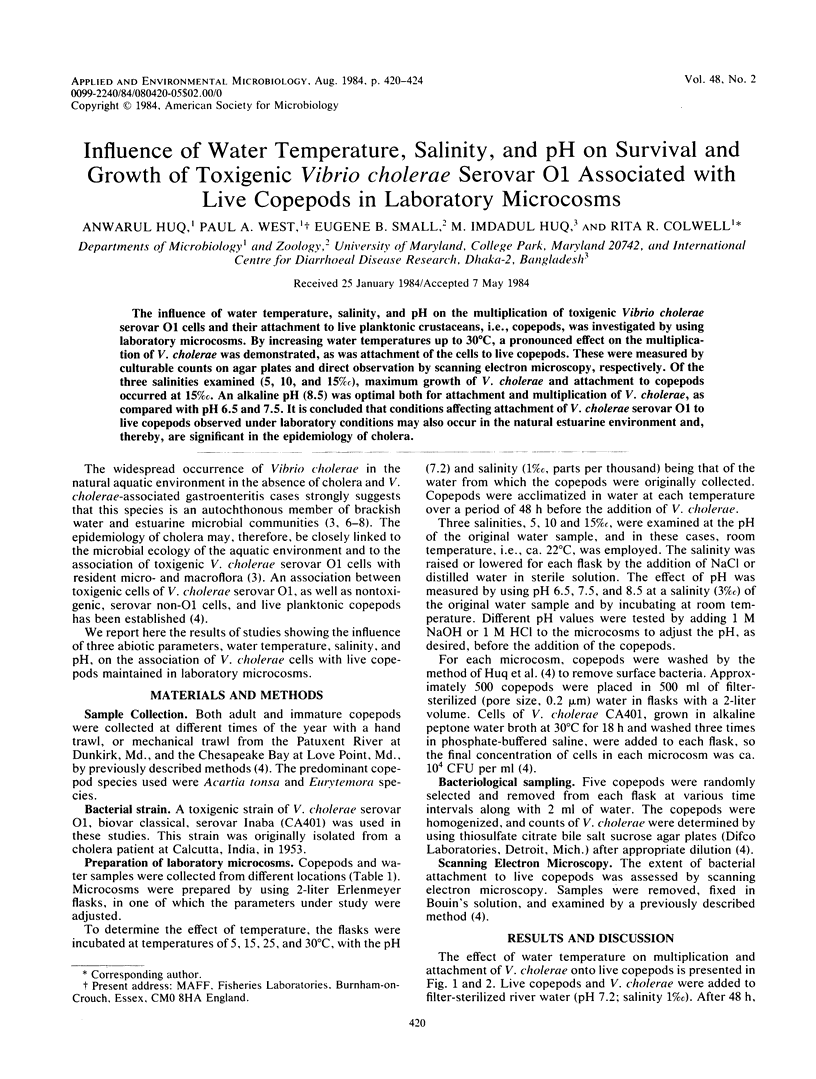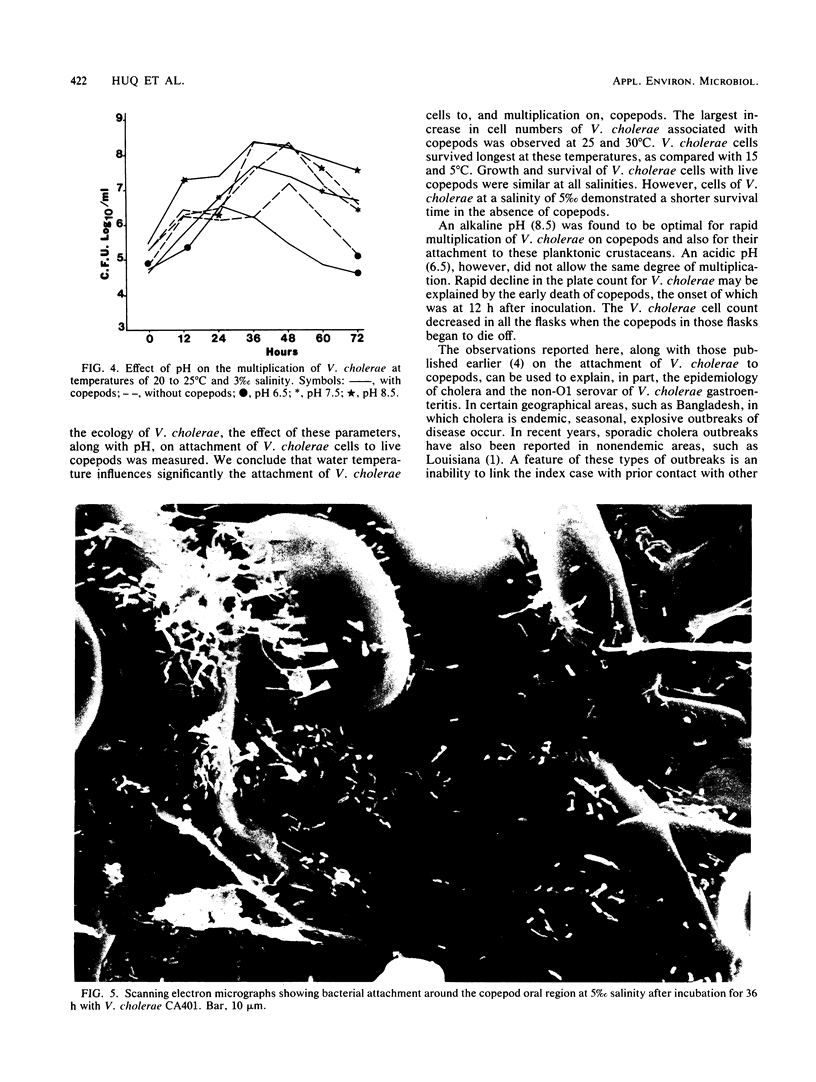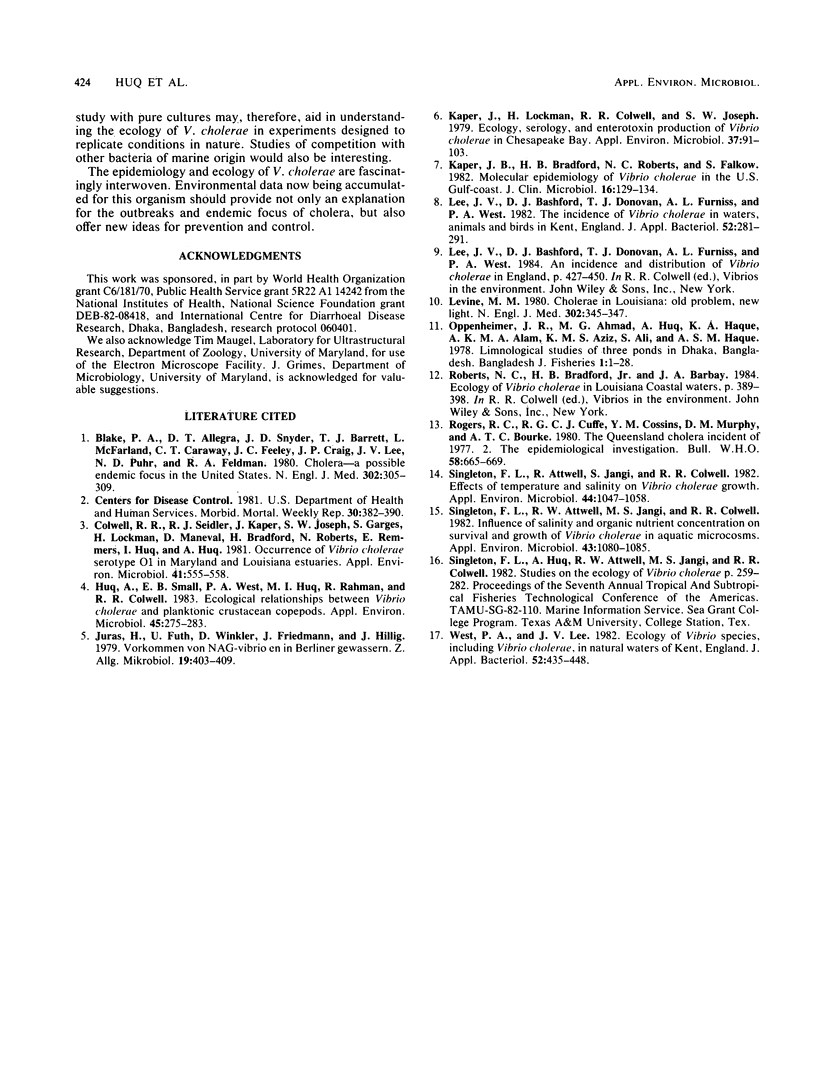Abstract
The influence of water temperature, salinity, and pH on the multiplication of toxigenic Vibrio cholerae serovar O1 cells and their attachment to live planktonic crustaceans, i.e., copepods, was investigated by using laboratory microcosms. By increasing water temperatures up to 30 degrees C, a pronounced effect on the multiplication of V. cholerae was demonstrated, as was attachment of the cells to live copepods. These were measured by culturable counts on agar plates and direct observation by scanning electron microscopy, respectively. Of the three salinities examined (5, 10, and 15%), maximum growth of V. cholerae and attachment to copepods occurred at 15%. An alkaline pH (8.5) was optimal both for attachment and multiplication of V. cholerae, as compared with pH 6.5 and 7.5. It is concluded that conditions affecting attachment of V. cholerae serovar O1 to live copepods observed under laboratory conditions may also occur in the natural estuarine environment and, thereby, are significant in the epidemiology of cholera.
Full text
PDF




Images in this article
Selected References
These references are in PubMed. This may not be the complete list of references from this article.
- Blake P. A., Allegra D. T., Snyder J. D., Barrett T. J., McFarland L., Caraway C. T., Feeley J. C., Craig J. P., Lee J. V., Puhr N. D. Cholera--a possible endemic focus in the United States. N Engl J Med. 1980 Feb 7;302(6):305–309. doi: 10.1056/NEJM198002073020601. [DOI] [PubMed] [Google Scholar]
- Colwell R. R., Seidler R. J., Kaper J., Joseph S. W., Garges S., Lockman H., Maneval D., Bradford H., Roberts N., Remmers E. Occurrence of Vibrio cholerae serotype O1 in Maryland and Louisiana estuaries. Appl Environ Microbiol. 1981 Feb;41(2):555–558. doi: 10.1128/aem.41.2.555-558.1981. [DOI] [PMC free article] [PubMed] [Google Scholar]
- Huq A., Small E. B., West P. A., Huq M. I., Rahman R., Colwell R. R. Ecological relationships between Vibrio cholerae and planktonic crustacean copepods. Appl Environ Microbiol. 1983 Jan;45(1):275–283. doi: 10.1128/aem.45.1.275-283.1983. [DOI] [PMC free article] [PubMed] [Google Scholar]
- Juras H., Futh U., Winkler D., Friedemann J., Hillig T. Vorkommen von NAG-Vibrionen in Berliner Gewässern. Z Allg Mikrobiol. 1979;19(6):403–409. doi: 10.1002/jobm.3630190606. [DOI] [PubMed] [Google Scholar]
- Kaper J. B., Bradford H. B., Roberts N. C., Falkow S. Molecular epidemiology of Vibrio cholerae in the U.S. Gulf Coast. J Clin Microbiol. 1982 Jul;16(1):129–134. doi: 10.1128/jcm.16.1.129-134.1982. [DOI] [PMC free article] [PubMed] [Google Scholar]
- Kaper J., Lockman H., Colwell R. R., Joseph S. W. Ecology, serology, and enterotoxin production of Vibrio cholerae in Chesapeake Bay. Appl Environ Microbiol. 1979 Jan;37(1):91–103. doi: 10.1128/aem.37.1.91-103.1979. [DOI] [PMC free article] [PubMed] [Google Scholar]
- Lee J. V., Bashford D. J., Donovan T. J., Furniss A. L., West P. A. The incidence of Vibrio cholerae in water, animals and birds in Kent, England. J Appl Bacteriol. 1982 Apr;52(2):281–291. doi: 10.1111/j.1365-2672.1982.tb04852.x. [DOI] [PubMed] [Google Scholar]
- Levine M. M. Cholera in Louisiana: old problem, new light. N Engl J Med. 1980 Feb 7;302(6):345–347. doi: 10.1056/NEJM198002073020609. [DOI] [PubMed] [Google Scholar]
- Rogers R. C., Cuffe R. G., Cossins Y. M., Murphy D. M., Bourke A. T. The Queensland cholera incident of 1977. 2. The epidemiological investigation. Bull World Health Organ. 1980;58(4):665–669. [PMC free article] [PubMed] [Google Scholar]
- Singleton F. L., Attwell R. W., Jangi M. S., Colwell R. R. Influence of salinity and organic nutrient concentration on survival and growth of Vibrio cholerae in aquatic microcosms. Appl Environ Microbiol. 1982 May;43(5):1080–1085. doi: 10.1128/aem.43.5.1080-1085.1982. [DOI] [PMC free article] [PubMed] [Google Scholar]
- Singleton F. L., Attwell R., Jangi S., Colwell R. R. Effects of temperature and salinity on Vibrio cholerae growth. Appl Environ Microbiol. 1982 Nov;44(5):1047–1058. doi: 10.1128/aem.44.5.1047-1058.1982. [DOI] [PMC free article] [PubMed] [Google Scholar]
- West P. A., Lee J. V. Ecology of Vibrio species, including Vibrio cholerae, in natural waters in Kent, England. J Appl Bacteriol. 1982 Jun;52(3):435–448. doi: 10.1111/j.1365-2672.1982.tb05074.x. [DOI] [PubMed] [Google Scholar]




